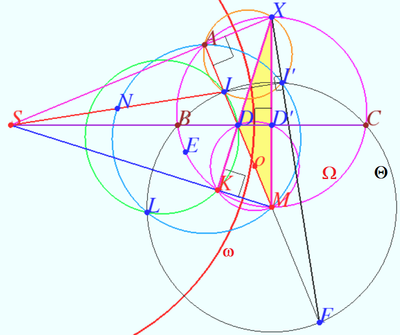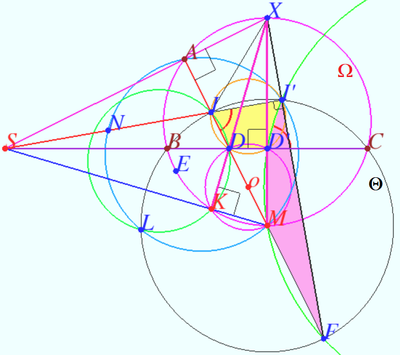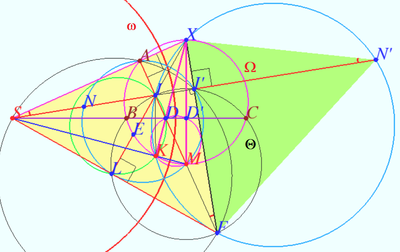Difference between revisions of "2017 USAMO Problems/Problem 3"
(Created page with "Contact v_Enhance at https://www.facebook.com/v.Enhance.") |
(→Solution: minor format fix) |
||
| (14 intermediate revisions by one other user not shown) | |||
| Line 1: | Line 1: | ||
| + | ==Problem== | ||
| + | Let <math>ABC</math> be a scalene triangle with circumcircle <math>\Omega</math> and incenter <math>I.</math> Ray <math>AI</math> meets <math>BC</math> at <math>D</math> and <math>\Omega</math> again at <math>M;</math> the circle with diameter <math>DM</math> cuts <math>\Omega</math> again at <math>K.</math> Lines <math>MK</math> and <math>BC</math> meet at <math>S,</math> and <math>N</math> is the midpoint of <math>IS.</math> The circumcircles of <math>\triangle KID</math> and <math>\triangle MAN</math> intersect at points <math>L_1</math> and <math>L.</math> Prove that <math>\Omega</math> passes through the midpoint of either <math>IL_1</math> or <math>IL.</math> | ||
| + | |||
| + | ==Solution== | ||
| + | [[File:2017 USAMO 3.png|400px|right]] | ||
| + | [[File:2017 USAMO 3a.png|400px|right]] | ||
| + | [[File:2017 USAMO 3b.png|400px|right]] | ||
| + | Let <math>X</math> be the point on circle <math>\Omega</math> opposite <math>M</math>. This means <math>\angle MAX = 90^\circ, BC \perp XM.</math> | ||
| + | |||
| + | <math>\angle XKM = \angle DKM = 90^\circ \implies</math> the points <math>X, D,</math> and <math>K</math> are collinear. | ||
| + | |||
| + | Let <math>D' = BC \cap XM \implies DD' \perp XM \implies</math> | ||
| + | |||
| + | <math>S</math> is the orthocenter of <math>\triangle DMX \implies</math> the points <math>X, A,</math> and <math>S</math> are collinear. | ||
| + | |||
| + | Let <math>\omega</math> be the circle centered at <math>S</math> with radius <math>R = \sqrt {SK \cdot SM}.</math> | ||
| + | |||
| + | We denote <math>I_\omega</math> inversion with respect to <math>\omega.</math> | ||
| + | |||
| + | Note that the circle <math>\Omega</math> has diameter <math>MX</math> and contain points <math>A, B, C,</math> and <math>K.</math> | ||
| + | |||
| + | <math>I_\omega (K) = M \implies</math> circle <math>\Omega \perp \omega \implies C = I_\omega (B), X = I_\omega (A).</math> | ||
| + | |||
| + | <math>I_\omega (K) = M \implies</math> circle <math>KMD \perp \omega \implies D' = I_\omega (D) \in KMD \implies</math> | ||
| + | <math>\angle DD'M = 90^\circ \implies</math> the points <math>X, D',</math> and <math>M</math> are collinear. | ||
| + | |||
| + | Let <math>F \in AM, MF = MI.</math> It is well known that <math>MB = MI = MC \implies</math> | ||
| + | |||
| + | <math>\Theta = BICF</math> is circle centered at <math>M.</math> <math>C = I_\omega (B) \implies \Theta \perp \omega.</math> | ||
| + | |||
| + | Let <math>I' = I_\omega (I ) \implies I' \in \Theta \implies \angle II'M = 90^\circ.</math> | ||
| + | <math>I' = I_\omega (I ), X = I_\omega (A ) \implies AII'X</math> is cyclic. | ||
| + | |||
| + | <math>\angle XI'I = \angle XAI = 90^\circ \implies</math> the points <math>X, I' ,</math> and <math>F</math> are collinear. | ||
| + | |||
| + | <math>I'IDD'</math> is cyclic <math>\implies \angle I'D'M = \angle I'D'C + 90^\circ = \angle I'ID + 90^\circ,</math> | ||
| + | <math>\angle XFM = \angle I'FI = 90^\circ – \angle I'IF = 90^\circ – \angle I'ID \implies</math> | ||
| + | |||
| + | <math>\angle XFM + \angle I'D'M = 180^\circ \implies I'D'MF</math> is cyclic. | ||
| + | |||
| + | Therefore point <math>F</math> lies on <math>I_\omega (IDK).</math> | ||
| + | |||
| + | <math>FA \perp SX, SI' \perp FX \implies I</math> is orthocenter of <math>\triangle FSX.</math> | ||
| + | |||
| + | <math>N</math> is midpoint <math>SI, M</math> is midpoint <math>FI, I</math> is orthocenter of <math>\triangle FSX, A</math> is root of height <math>FA \implies AMN</math> is the nine-point circle of <math>\triangle FSX \implies I' \in AMN.</math> | ||
| + | |||
| + | Let <math>N' = I_\omega (N) \implies R^2 = SN \cdot SN' = SI \cdot SI' \implies</math> | ||
| + | <cmath>\frac {SN'}{SI'} = \frac {SI}{SN} =2 \implies</cmath> | ||
| + | <math>\angle XN'I' = \angle XSI' = 90^\circ – \angle AXI' = \angle IFX \implies N'XIF</math> is cyclic. | ||
| + | |||
| + | Therefore point <math>F</math> lies on <math>I_\omega (AMN) \implies I_\omega(F) = L \implies</math> | ||
| + | |||
| + | The points <math>F, L,</math> and <math>S</math> are collinear, <math>AXFL</math> is cyclic. | ||
| + | |||
| + | Point <math>I</math> is orthocenter <math>\triangle FSX \implies XI \perp SF, \angle ILS = \angle SI'F = 90^\circ</math> | ||
| + | <math>\implies</math> The points <math>X, I, E,</math> and <math>L</math> are collinear. | ||
| + | |||
| + | <math>AXFL</math> is circle <math>\implies AI \cdot IF = IL \cdot XI\implies</math> | ||
| + | |||
| + | <math>AI \cdot \frac {IF}{2} = \frac {IL}{2} \cdot IX \implies AI \cdot IM = EI \cdot IX \implies AEMX</math> is cyclic. | ||
| + | <cmath>E \in \Omega.</cmath> | ||
| + | '''vladimir.shelomovskii@gmail.com, vvsss''' | ||
| + | |||
| + | ==Contact== | ||
Contact v_Enhance at https://www.facebook.com/v.Enhance. | Contact v_Enhance at https://www.facebook.com/v.Enhance. | ||
| + | |||
| + | {{MAA Notice}} | ||
Latest revision as of 18:24, 8 May 2023
Problem
Let ![]() be a scalene triangle with circumcircle
be a scalene triangle with circumcircle ![]() and incenter
and incenter ![]() Ray
Ray ![]() meets
meets ![]() at
at ![]() and
and ![]() again at
again at ![]() the circle with diameter
the circle with diameter ![]() cuts
cuts ![]() again at
again at ![]() Lines
Lines ![]() and
and ![]() meet at
meet at ![]() and
and ![]() is the midpoint of
is the midpoint of ![]() The circumcircles of
The circumcircles of ![]() and
and ![]() intersect at points
intersect at points ![]() and
and ![]() Prove that
Prove that ![]() passes through the midpoint of either
passes through the midpoint of either ![]() or
or ![]()
Solution
Let ![]() be the point on circle
be the point on circle ![]() opposite
opposite ![]() . This means
. This means ![]()
![]() the points
the points ![]() and
and ![]() are collinear.
are collinear.
Let ![]()
![]() is the orthocenter of
is the orthocenter of ![]() the points
the points ![]() and
and ![]() are collinear.
are collinear.
Let ![]() be the circle centered at
be the circle centered at ![]() with radius
with radius ![]()
We denote ![]() inversion with respect to
inversion with respect to ![]()
Note that the circle ![]() has diameter
has diameter ![]() and contain points
and contain points ![]() and
and ![]()
![]() circle
circle ![]()
![]() circle
circle ![]()
![]() the points
the points ![]() and
and ![]() are collinear.
are collinear.
Let ![]() It is well known that
It is well known that ![]()
![]() is circle centered at
is circle centered at ![]()
![]()
Let ![]()
![]() is cyclic.
is cyclic.
![]() the points
the points ![]() and
and ![]() are collinear.
are collinear.
![]() is cyclic
is cyclic ![]()
![]()
![]() is cyclic.
is cyclic.
Therefore point ![]() lies on
lies on ![]()
![]() is orthocenter of
is orthocenter of ![]()
![]() is midpoint
is midpoint ![]() is midpoint
is midpoint ![]() is orthocenter of
is orthocenter of ![]() is root of height
is root of height ![]() is the nine-point circle of
is the nine-point circle of ![]()
Let ![]()
![]()
![]() is cyclic.
is cyclic.
Therefore point ![]() lies on
lies on ![]()
The points ![]() and
and ![]() are collinear,
are collinear, ![]() is cyclic.
is cyclic.
Point ![]() is orthocenter
is orthocenter ![]()
![]() The points
The points ![]() and
and ![]() are collinear.
are collinear.
![]() is circle
is circle ![]()
![]() is cyclic.
is cyclic.
![]() vladimir.shelomovskii@gmail.com, vvsss
vladimir.shelomovskii@gmail.com, vvsss
Contact
Contact v_Enhance at https://www.facebook.com/v.Enhance.
The problems on this page are copyrighted by the Mathematical Association of America's American Mathematics Competitions. 












